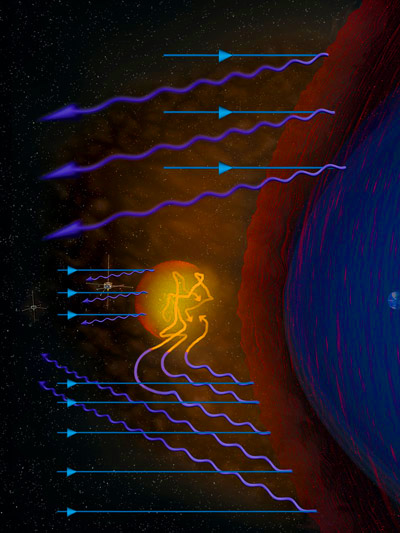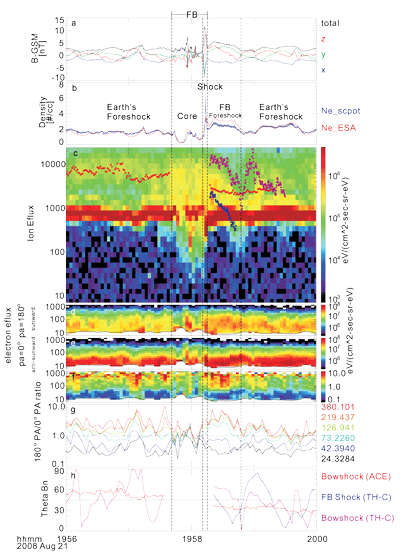
2016 THEMIS SCIENCE NUGGETS
Observations of a new foreshock region upstream of a foreshock bubble's shock
by Terry Z. Liu
UCLA EPSS
Introduction
Energetic particles are one way to observe basic principles in our universe, especially how they behave in response to magnetic fields. The solar wind, a plasma flow ejected from the sun, is supersonic. So when the solar wind propagates towards Earth and gets blocked by Earth's magnetic field, a giant shockwave called the "bow shock" forms. Earth's bow shock can reflect and accelerate some of the solar wind plasma, and this sunward reflected plasma forms a region called the foreshock. When the reflected plasma encounters a sharp change of interplanetary magnetic field (i.e., a solar wind discontinuity), the reflected plasma can become trapped and thermalized. This trapped, thermalized plasma population can expand and form a plasma bubble called a foreshock bubble. Due to the fast expansion of the foreshock bubble against the supersonic solar wind, a shock can form ahead of the foreshock bubble. This shock (the foreshock bubble's shock or FB shock) can in turn reflect and accelerate some of the solar wind plasma like Earth's bow shock, and form its own new foreshock.
Shocks are a major particle accelerator in our universe, for example, solar energetic particles could be accelerated at shocks driven by coronal mass ejections (CME), while cosmic rays are related to supernova shocks. However, how these shocks accelerate particles has not been fully understood. What is the particle source of acceleration at quasi-perpendicular CME-driven shocks? Why can quasi-parallel supernova shocks accelerate particles more efficiently than expected from theory? Our results could provide a hint to solve these shock acceleration problems: the foreshock bubble's shock can be both an additional accelerator and also a particle source of parent shock acceleration. To solve shock acceleration problems, we need to consider not only the shock itself but also its upstream transient phenomena. In this study, we examine particle acceleration at the foreshock bubble's shock.
| Figure 1. A baby foreshock emerges from its parent foreshock. Incoming solar wind ion beams (blue arrows) get reflected (spiral purple arrows) at Earth's bow shock (red, far right). These reflected ions form Earth's parent foreshock (faint orange glow) and gradually become diffuse (blurred spiral purple arrows). In this study, a solar wind discontinuity was observed by the THEMIS-B spacecraft (far left), causing some of the reflected foreshock ions to become trapped and thermalized (center, purple arrows bending to become yellow arrows in random directions). These hot ions expand and form a foreshock bubble with a hot core (yellow) and its own shock (red) due to fast expansion. The THEMIS-C spacecraft (center) observed that this new shock can also reflect solar wind ion beams (blue arrows) and form a baby foreshock (spiral purple arrows with orange glow, center). Image Credit: Emmanuel Masongsong and Heli Hietala, UCLA; NASA EYES. |
Results
TH-C at [16.9, 1.6, -3.6] RE in GSM near the bow shock observed a foreshock bubble and its shock as shown in Figure 2 (from 19:57:42 UT to 19:58:15 UT). Immediately after the FB shock observation, ion energy flux enhanced at ~2 keV (panel c). Because the interplanetary magnetic field was connected to the FB shock at this moment, these energetic ions were very likely reflected and accelerated at the FB shock. To prove this, we theoretically calculated the ion beam energy adiabatically reflected at the FB shock (blue dots in panel c) which is very consistent with the observation. If we assume the ions were reflected at the bow shock, the calculated ion energy (red dots and purple dots) is inconsistent with the observation. Furthermore, our consistent calculations and observed ion distribution functions show that these reflected ions were actually moving earthward. This is because the ions reflected at the FB shock should convect with the FB shock towards Earth. Therefore, we confirm that the observed energetic ions were adiabatically reflected at the FB shock and formed a new ion foreshock in addition to the parent Earth's foreshock.
| Figure 2. TH-C observation of the event. From top to bottom: (a) magnetic field components in GSM coordinates (XYZ in blue, green, and red, respectively) and magnitude (black); (b) electron density from ESA (red) and EFI (blue); (c) ion energy flux spectrum (blue dots represent the calculated ion energy reflected by the FB shock using TH-C magnetic field, purple dots and red dots represent the calculated ion energy reflected by the bow shock using TH-C and shifted (by ~3480s) ACE magnetic field, respectively); (d) 180° pitch angle electron energy flux; (e) 0° pitch angle electron energy flux; (f) the ratio of 0° to 180° pitch angle electron energy flux (spectrum); (g) the ratio of 0° to 180° pitch angle electron energy flux at different energy (line plot); (h) θ_Bn of the FB shock (blue) and local bow shock (purple: from TH-C magnetic field data, red: from shifted ACE field data). |
Meanwhile, the 180° pitch angle (sunward) electron flux (Figure 2d) enhanced immediately after the FB shock observation while the 0° pitch angle (anti-sunward) electron flux (Figure 2e) did not vary obviously. This causes the energy flux ratio of sunward electrons to anti-sunward electrons (Figure 1f and 1g) at energy above 50 eV increased to around 5-7 and then gradually decreased to 1, the background level. Thus, more high-energy sunward field-aligned electrons from the FB shock were observed than electrons from the background local bow shock: a new electron foreshock was formed.
Conclusion
Our work is the first definite observation of a new ion and electron foreshock upstream of a foreshock bubble's shock, in addition to Earth's parent foreshock. We confirmed that the foreshock bubble's shock can accelerate particles through adiabatic reflection (shock drift acceleration). Our study indicates that the foreshock bubble's shock could provide an additional accelerator and also a particle source of diffusive shock acceleration for quasi-parallel parent shocks propagating through nonuniform media throughout the universe.
Reference
Liu, T. Z., H. Hietala, V. Angelopoulos, and D. L. Turner (2016), Observations of a new foreshock region upstream of a foreshock bubble's shock, Geophys. Res. Lett., 42, doi:10.1002/2016GL068984.Biographical Note
Terry Liu is a PhD student in space physics at the University of California, Los Angeles. He is studying the Earth's bow shock and related upstream particle phenomena.
 Please send comments/suggestions to
Emmanuel Masongsong / emasongsong @ igpp.ucla.edu
Please send comments/suggestions to
Emmanuel Masongsong / emasongsong @ igpp.ucla.edu


